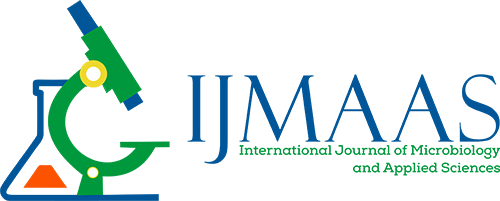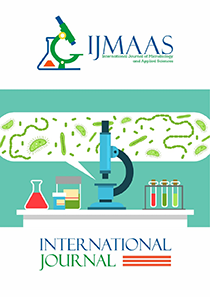GUIDELINES TO AUTHORS
International Journal of Microbiology and Applied Sciences (ijmaas) is a peer-reviewed journal concerned with publishing articles on the most outstanding research in the spectrum of microbiology and applied sciences.
The International Journal of Microbiology and Applied Sciences (ijmaas) welcomes original research papers from Research scholars, Academicians, industrialists in the area of microbiology and applied science and Publish Triannually; that is three (3) times a year or every four (4) Months.
Papers submitted by the authors/co-authors must be original in nature. No part(s) of the paper is/are not currently sent to any journal, international journal or any other publication company for consideration. The authors who are willing to submit paper should ensure that they get approval from their coauthors. Acknowledgement will be sent to corresponding author after receipt of paper. Before publication of paper in the journal, further correspondence will be sent to the respective author(s).
Submission of paper: only send through e-mail, the table, chart, figures should be done in MS-word file in times new Roman. Email: admin@ijmaas.com immediately after the receipt of paper of Manuscript Number will be sent to the author within a day or maximum of two days. The mail should contain the authors’ full address, telephone number and designation. IJMAAS follows Double-Blind Peer Review: Reviewers do not know the identity of the author(s), and the author(s) do not know the identity of the reviewer. (IJMAAS designate reviewers to review the articles from a pool of ijmaas reviewers)
Note: The International Journal of Microbiology and Applied Sciences (ijmaas) accept Manuscripts only through e-mail.
Authors are requested to abide by the established specifications, failure in doing them may result in manuscripts being delayed or discarded. Therefore authors are strongly encouraged to read these guidelines/instructions carefully before preparing a manuscript for submission. The manuscripts should be checked carefully for grammatical errors. All manuscripts are subjected to peer review by well qualified and experienced editorial team members.
International Journal of Microbiology and Applied Sciences (IJMAAS) believes that the manuscript is not under consideration anywhere else, and once accepted shall not be published elsewhere in the same form, in either the same or another language, without the consent of the Editors. Manuscripts with multiple authors are reviewed assuming that all listed authors have contributed to the research and all have unanimously approved the final manuscript. Authors must submit a covering letter along with the manuscript declaring the authenticity behind the work.
Types of manuscripts
Research papers should contain new experimental studies that constitute a significant contribution to the respective field. Research Papers should not exceed twelve (12) pages.
Short communications are the one that contain new important findings in brief, a maximum of six (6) pages.
Review articles should take into context the most important current topics but not mere compilation, on subjects of general interest. They should not exceed twelve (12) pages.
Manuscripts preparations
The language of the journal is English. Manuscript should be typed in Times New Roman font, one and a half-spaced on A4 (8.5″ × 11″) paper size with 1 inch margins. Title should be in bold face upper case with font size of 14, main headings should be in bold face upper case with font size 12 and subheadings should be in bold face lower case. It should be arranged in the following order: Title, Abstract, Keywords, Introduction, Materials and Methods, Results, Discussion, Conclusion, Acknowledgement, References.
Title Page
The title must be as brief as possible, comprehensive and descriptive. Each author must provide their full name including their forenames and surname followed by their address in normal face lower case. The Corresponding Author of the manuscript must be marked with an asterisk, and should be listed first. In addition the corresponding author must include telephone/ fax/ E-mail address below the corresponding authors name. If any of the co-authors are from different organizations, their addresses too should be mentioned and indicated using numbers after their names.
Abstract
Should start on a new page after the title page and should not be more than 250 words. It must present the reason behind the study, the main findings, and conclusions. All the three categories, Review Articles, Research papers and Short Communications should have an Abstract.
Keywords
Provide four to six appropriate key words after abstract.
Introduction
Should start on a new page. Introduction must be clear and should justify the title, relate the current research with earlier researches and should clearly indicate the objectives of the study.The background regarding the research, nature of hypothesis should be clearly stated. The introduction should be understandable to researchers from various science disciplines.
Materials and Methods
Shall start as a continuation to introduction on the same page. Materials and methods do not refer to common place statistical test. It must be enough to allow experiments to be reproduced. All important materials used along with their source shall be mentioned. The main methods used shall be briefly described, citing references. New or modified methods may be described in detail. The statistical method and the level of significance chosen shall be clearly stated. Subheadings should be used.
Results
Results of research articles or manuscripts should be present with clarity and precise.
Tables and Figures in the research paper should be kept minimum and simple. It should be inserted in the appropriate place within the text. All results presented in tabular or graphical form shall be described in this section. All Tables and figures must have a title and a legend to make them self-explanatory and they should be given numbers. Previous publisher’s findings should be written in present tense. Results should be explained. Discussion, interpretation should be included in the results but should be put into the discussion section.
Discussion
Discussion part of the research paper includes the sub heading, significance of the results related to research work. It should contain a critical review of the results of the study with the support of relevant literature or a review of results with previous research.
Conclusion
Shall contain brief conclusion of the investigation followed by future prospects.
Acknowledgements
All acknowledgments should be in a brief manner and should be typed in one paragraph directly preceding the reference section.
References
In the text, a reference identified by means of an author‘s name should be followed by the date of the reference in parentheses. When there are more than two authors, only the first author‘s name should be mentioned, followed by ’et al‘. In the event that an author cited has had two or more works published during the same year, the reference, both in the text and in the reference list, should be identified by a lower case letter like ’a‘ and ’b‘ after the date to distinguish the works.
Cite references in text, tables and legends. Avoid using abstracts as references. Avoid citing a “personal communication” unless it provides essential information not available from a public source, in which case the name of the person and date of communication should be cited in parentheses in the text.
References should be listed at the end of the paper in alphabetical order. Journal names are abbreviated according to Chemical Abstracts. Authors are fully responsible for the accuracy of the references.
Examples
Journals: Author (last name) (initials), Author (last name) (initials), Title of Article, Journal name, volume (issue), year, page numbers.
Books: Author (last name) (initials), Author (last name) (initials), Author (last name) (initials), Title of Book, Ed, Vol, Publisher, City, year, page numbers. Conference Proceedings: Author AB, Title, Conference, year, page number.
Ethics
Evidence for approval by a local Ethics Committee (for both human as well as animal studies) must be supplied by the authors on demand.
Manuscript Submission
Type-written manuscripts prepared using MS Word should be submitted as a MS word document to admin@ijmaas.com
Proofs and Reprints
Electronic proofs will be sent (e-mail attachment) to the corresponding author as a PDF file. Page proofs are considered to be the final version of the manuscript. Authors can freely download the PDF file from which they can print unlimited copies of their article(s).
Copyright
Submission of a manuscript implies; that the work described has not been published before (except in the form of an abstract or as part of a published lecture, or thesis) that it is not under consideration for publication elsewhere; that if and when the manuscript is accepted for publication, the authors agree to automatic transfer of the copyright to the publisher.
Fees and Charges
Authors are required to pay Forty thousand Naira (N40,000) only for Nigerian authors and 100U$ for foreign authors towards as a processing fee. Publication of an article in the International Journal of Microbiology and Applied Sciences (IJMAAS) is not contingent upon the author’s ability to pay the charges. Neither is acceptance to pay the processing fee a guarantee that the paper will be accepted for publication.
Bank Details
Bank Name: United Bank for Africa (UBA)
Branch: Rivers State University Main Campus, Port Harcourt, Nigeria
Account Name: International Journal of Microbiology and Applied Sciences
Account Number: 2305757041 (Savings Account)
Terms
After acceptance of the manuscript with the journal formatted proof, authors would have to pay the processing charges as prescribed in the guidelines to authors. Once paid the processing fee is non-refundable from publishers. Because we are charging only the processing fees, it includes the reviewer’s report preparation, editing, proofreading, design, formatting, and maintenance.

